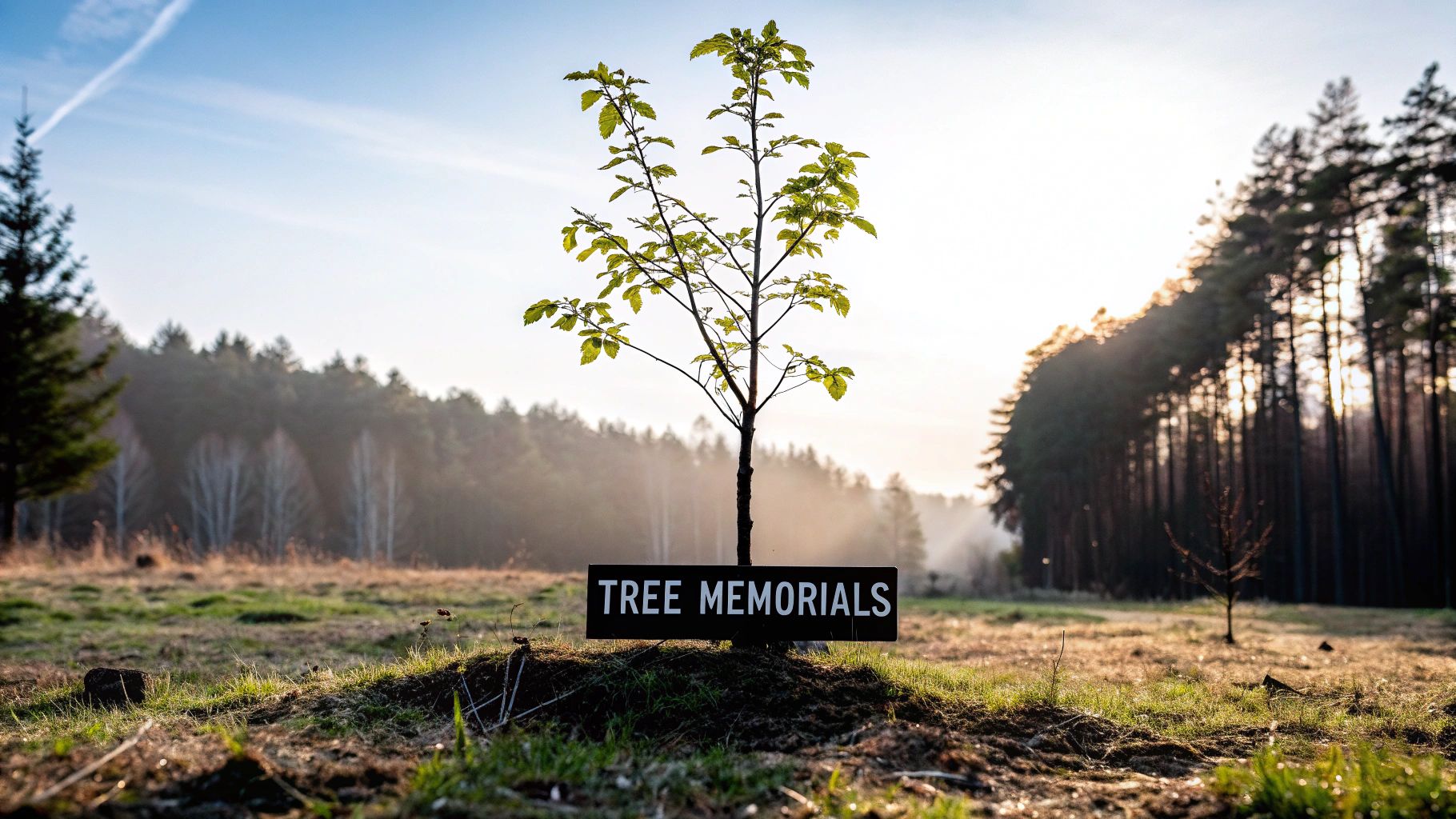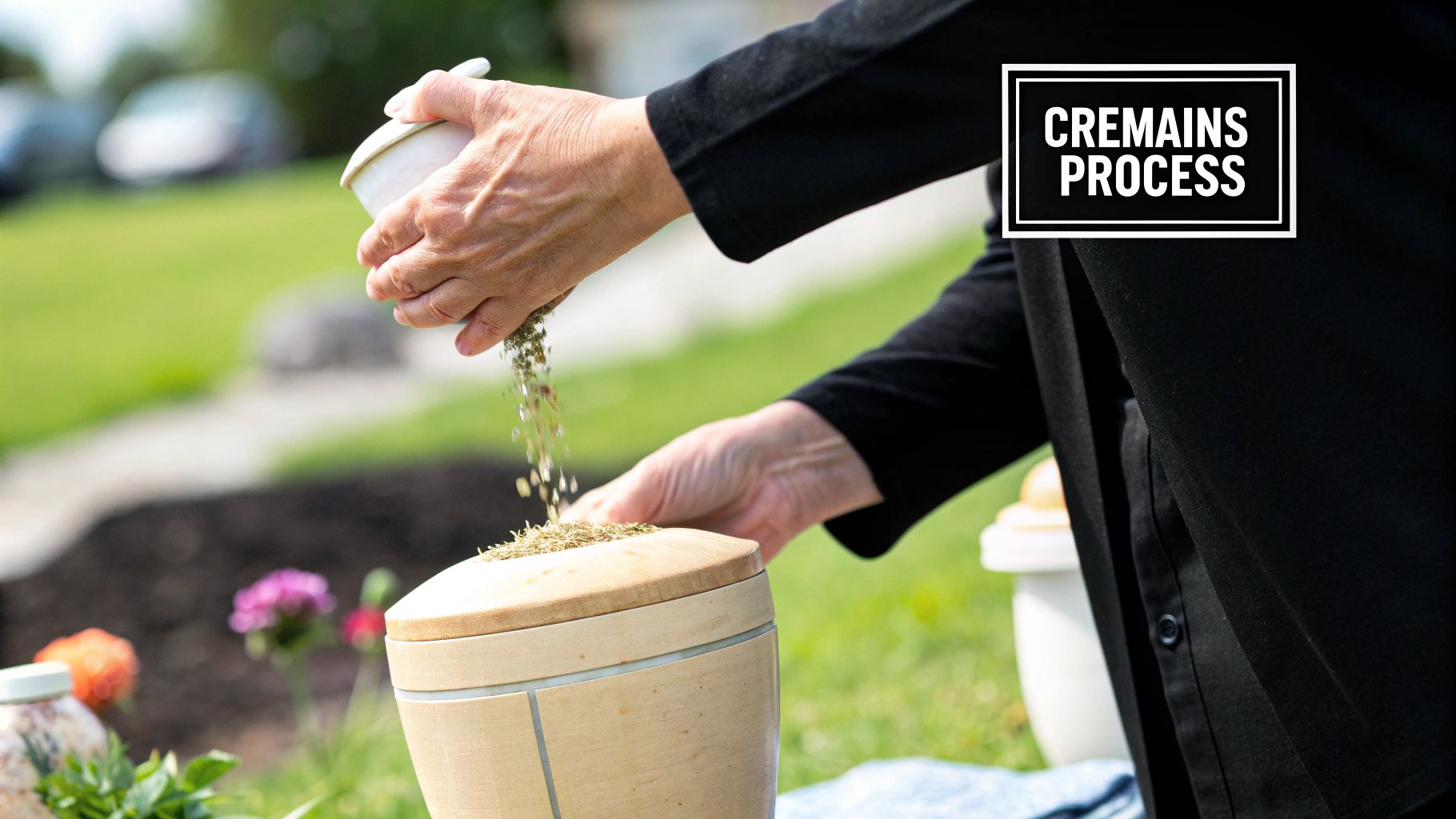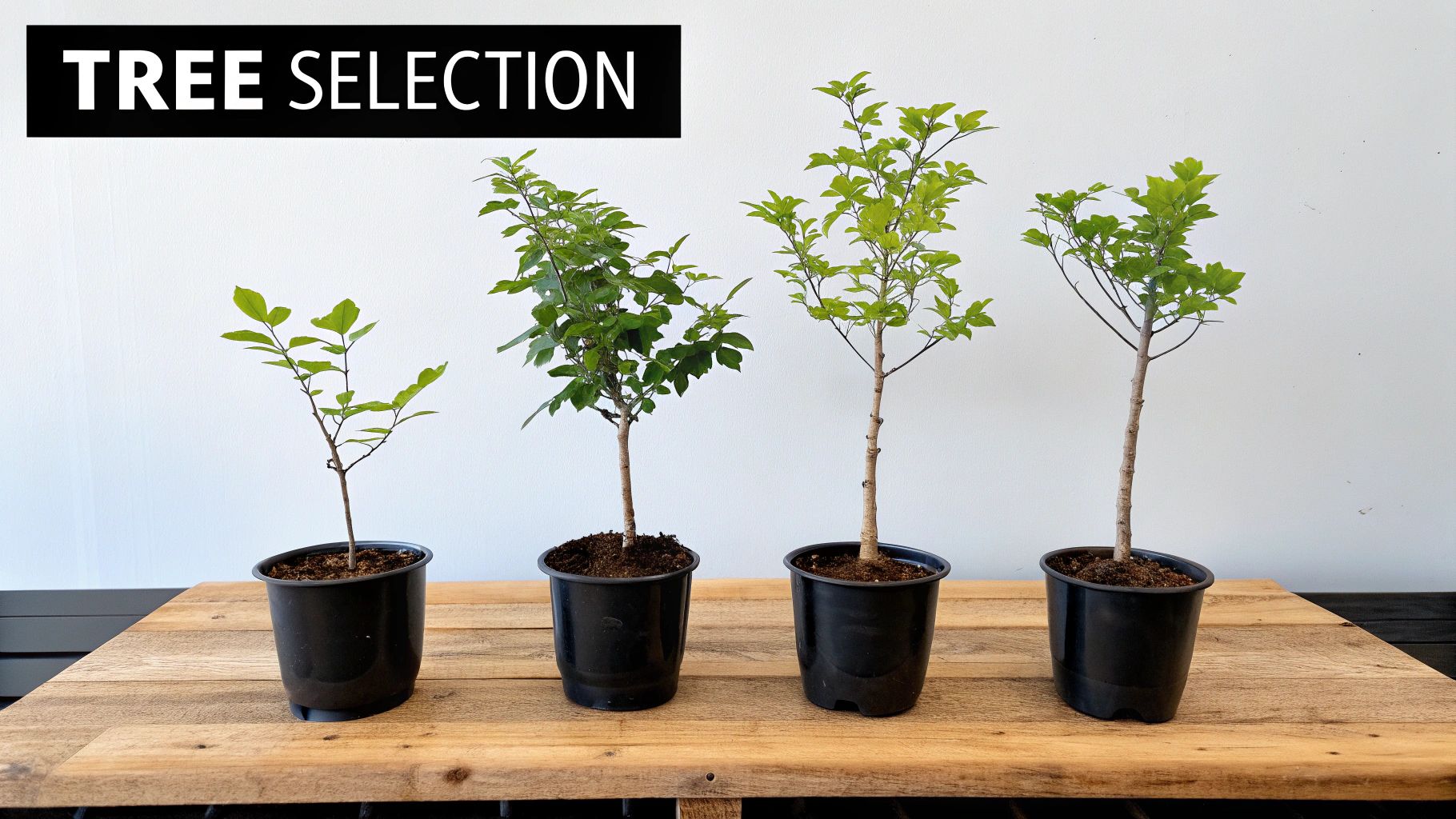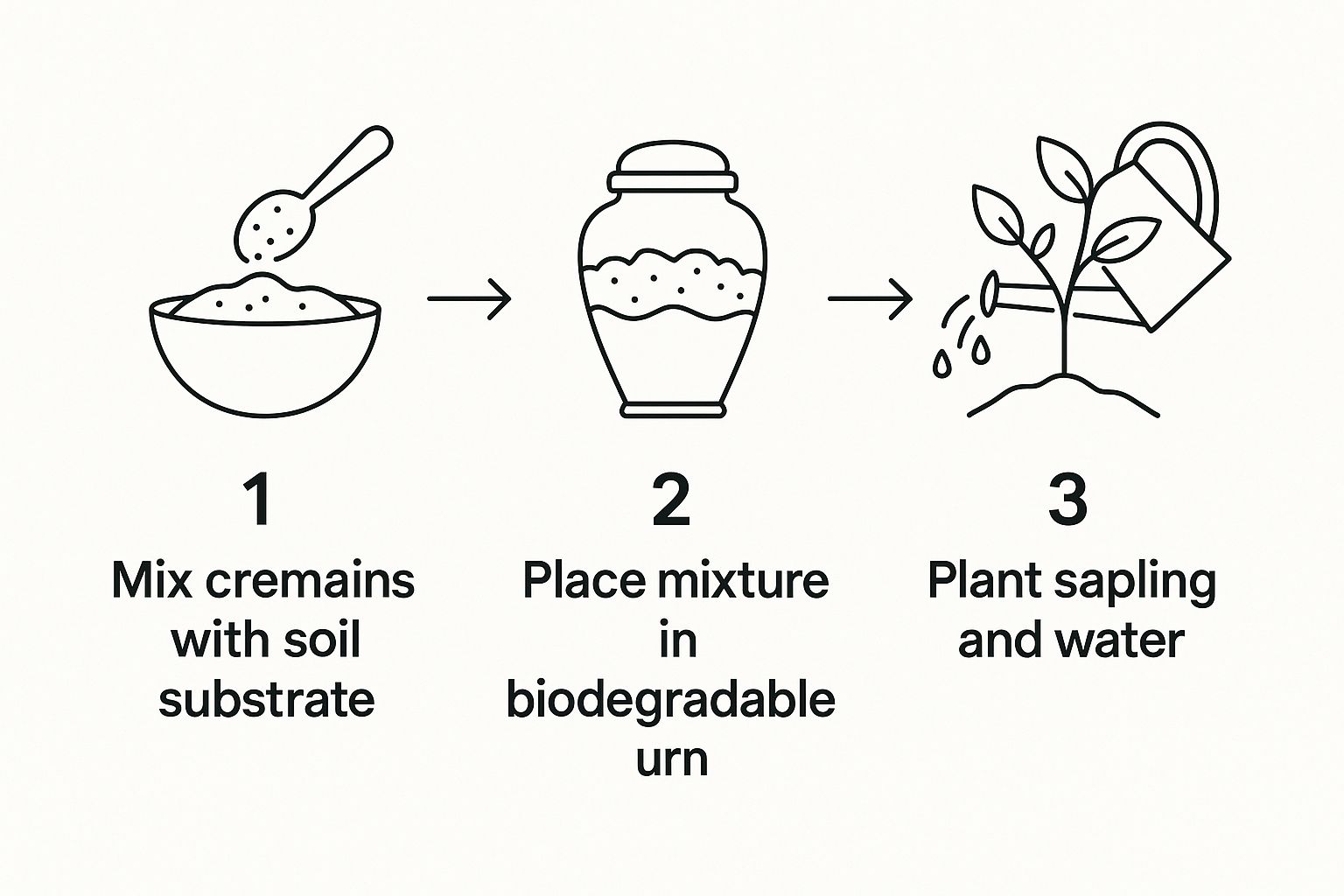Turning cremains into a tree is a beautiful way to create a living, breathing tribute to someone you've lost. This isn't just about remembrance; it's about transformation. You're creating a legacy that grows stronger with each season, a powerful symbol of continuity and regeneration.
Why a Living Memorial Is Such a Meaningful Choice

Opting for a living memorial is part of a larger shift toward more personal and earth-friendly tributes. Instead of a static headstone, a memorial tree gives you a dynamic, evolving connection—a place to visit, reflect, and literally watch new life emerge from your love. It feels less like an ending and more like a continuation of their story.
This approach speaks directly to the growing desire for greener end-of-life choices. Cremation is already on track to be the preferred choice for nearly 80% of funerals by 2040, and a major reason for this is environmental awareness. In fact, studies show that 91% of people consider a funeral's impact on the planet to be significant.
A living memorial is a direct, positive response to that concern. It transforms an act of remembrance into an act of ecological restoration. You can read more about these eco-conscious trends and find other data right here.
Embracing a Legacy of Growth
At its heart, the idea of turning ashes into a tree is about rebirth. It offers a profound sense of peace, knowing that a loved one’s final essence is nurturing the earth. Over time, that memorial tree becomes a natural focal point for family, a place for memories to take root and for future generations to connect with their heritage.
There are a few unique benefits that really resonate with people who make this choice:
- A Lasting Connection to Nature: It forges a tangible, physical bond between a loved one's memory and the natural world.
- A Symbol of Continuity: A tree's life cycle, from a delicate sapling to a towering, resilient presence, beautifully mirrors the enduring nature of love and memory.
- An Eco-Conscious Tribute: It actively gives back to the environment by producing oxygen, creating a home for wildlife, and making the world a bit more beautiful.
By choosing a living memorial, you are not just saying goodbye; you are planting a story. It’s a tribute that breathes, grows, and gives back, creating a beautiful and enduring symbol of a life well-lived.
This is just one of many modern ways to create a unique tribute. If you're exploring different possibilities, our guide on meaningful funeral remembrance ideas offers more inspiration for a personal and fitting farewell. While a tree offers a deeply rooted tribute, other services like Aerial Ash Scattering provide a different kind of return to nature, celebrating a spirit of freedom and a connection to the open skies.
Understanding Cremains and Their Impact on Soil

Before you even pick up a shovel, it's vital to understand what cremated remains are and how they interact with the earth. It's a common misconception that you can simply mix ashes into the soil. In reality, doing this can create a toxic environment for a new tree, especially a young sapling.
The main issue comes down to chemistry. Cremains are incredibly alkaline, with a pH level often between 11 and 12. To put that in perspective, most trees thrive in soil that's closer to neutral, somewhere in the 6.0 to 7.0 pH range. Introducing something so alkaline shocks the root system and essentially locks up vital nutrients, starving the tree before it even has a chance to grow.
Beyond the pH problem, cremains also have a very high salt content, primarily sodium. A little salt is one thing, but this much is another. Excessive sodium messes with the tree's ability to draw water up through its roots, a process called osmosis. The result is a tree that can't get enough water, even if the ground is damp, leading to dehydration and eventual failure.
Creating the Right Conditions for a Thriving Tree
So, how do you bridge the gap? The key is to neutralize these harsh properties before planting. This is exactly what specialized soil amendments and memorial urn systems are designed for. They aren't just fancy additions; they are scientifically formulated to counteract the high pH and salt levels.
These mixtures introduce specific organic materials and minerals that buffer the alkalinity and dilute the sodium. It’s like adding the perfect balancing ingredients to a recipe. This crucial step transforms the cremains from a potentially harmful substance into a nurturing part of the soil, giving your memorial tree the foundation it needs.
By properly preparing the cremains with a soil amendment, you're doing more than just planting a tree. You're creating a sustainable, living tribute that has everything it needs to flourish for generations to come.
Choosing the Right System: Bio-Urns and Amendment Kits
You have a couple of excellent options for making this process safe and straightforward. Each one is designed to effectively prepare the cremains for their new role in supporting life.
- Soil Amendment Kits: These are specially formulated mixtures that you combine with the cremains and the soil when you plant the tree. They get to work immediately, lowering the pH and binding the excess salts so they can't harm the delicate roots.
- Biodegradable Urns: Many memorial tree kits include a biodegradable urn that does the work for you. Typically, the cremains go into one section, and a separate compartment contains a neutralizing agent. As the urn naturally breaks down in the soil, it slowly and safely releases the treated ashes into the surrounding earth.
While the texture of cremains can differ, their chemical makeup is what presents the challenge. If you're curious, you can learn more about what cremation ashes look like in our detailed guide. Seeing their composition really drives home why these preparatory steps are non-negotiable for a healthy tree. Of course, there are other beautiful memorial options, like those from Aerial Ash Scattering, that return a loved one to nature without these specific soil considerations.
Choosing the Perfect Tree for Your Memorial

Selecting the right tree is probably the most personal part of creating this living tribute. It's a decision that really blends heart and head—finding a tree that not only feels right but also has the best chance to flourish for generations to come.
The best place to start is with the practical side of things. A tree that can’t handle your local environment will struggle, no matter how much love you pour into it. To give your sapling a strong start, you need to match it to your specific conditions.
Think first about your local climate. Every area has a designated USDA Plant Hardiness Zone, which is just a simple way of knowing which plants can withstand the winter temperatures where you live. Sticking with trees native to your zone is a huge first step toward ensuring a healthy, resilient memorial.
Matching the Tree to Your Yard
Once you’ve narrowed it down by climate, take a good look at the exact spot you plan to plant. Does it get blasted with sun all day, or is it mostly shade? Is your soil sandy and dry, or is it a heavy clay that stays wet? These details make all the difference.
A moisture-loving River Birch, for example, would be miserable in dry, sandy soil. On the other hand, a tough, drought-tolerant Oak might have a hard time in a soggy, waterlogged spot. I always recommend people spend some time just observing their yard to see how the light and water behave throughout the day. It provides so many clues.
A thriving memorial tree needs the right foundation. When you match the tree to your climate and soil, you're giving it the best possible chance for a long and vibrant life—creating a tribute that grows stronger with each passing year.
Finding Meaning in the Species
After you have a solid list of trees that will actually grow well in your yard, the fun part begins: exploring the symbolism. This is where you can connect the tree directly to the personality and spirit of the person you're honoring.
Different trees carry their own unique stories and feelings.
- Oak Trees: These are all about strength, wisdom, and endurance. An oak can be a powerful choice for someone who was a rock for their family or community.
- Birch Trees: With their beautiful, peeling bark, birches symbolize new beginnings, renewal, and hope.
- Maple Trees: Often associated with balance, generosity, and warmth, maples are a wonderful tribute to a kind and giving soul.
- Cherry Blossoms: A poignant symbol of the fleeting, yet beautiful, nature of life. A truly meaningful choice.
To help you find the perfect fit, we've put together a quick guide comparing some popular choices based on where you live.
Memorial Tree Selection Guide by Region
| Tree Species | Best Climate/Region | Mature Size | Symbolic Meaning |
|---|---|---|---|
| Oak | Widespread (Hardy in Zones 3-9) | 50-80 ft tall | Strength, endurance, wisdom |
| Maple | Northern & Eastern US (Zones 3-8) | 40-60 ft tall | Balance, generosity, harmony |
| Dogwood | Eastern & Southern US (Zones 5-9) | 15-30 ft tall | Purity, resilience, rebirth |
| Ginkgo Biloba | Urban areas, adaptable (Zones 3-8) | 25-50 ft tall | Longevity, hope, peace |
| Crepe Myrtle | Southern US (Hot climates, Zones 7-10) | 15-25 ft tall | Beauty, love, long life |
| Blue Spruce | Colder Northern climates & mountains (Zones 2-7) | 50-75 ft tall | Protection, eternal life, nobility |
This is just a starting point, of course. The goal is to find a tree that resonates with you and has the best chance of becoming a lasting, living legacy.
There are countless species to consider, and for more inspiration, exploring different memorial tree ideas can help you find that perfect match. Ultimately, the best tree is one that feels right to you and will thrive in its new home.
Planting Your Living Memorial
This is the moment where all your thoughtful preparation comes together. Planting the tree is more than just a step in a process; it's a meaningful ceremony, a bridge between a cherished memory and new, growing life. Getting it right ensures the experience is both beautiful and successful for your living memorial.
This simple infographic gives a great overview of the core planting steps.

As you can see, the key is properly preparing the cremains before they ever get near the young tree. This creates a healthy foundation from day one.
Getting the Cremains and Planting Site Ready
First things first, and this is critical: you must prepare the cremains. Never add untreated ashes directly to the soil. You’ll need a specialized soil amendment kit designed to neutralize the high pH and salt content that is otherwise toxic to plants. Just carefully follow the instructions that come with your kit, gently mixing the ashes with the amendment until they’re fully incorporated.
Once your cremains mixture is ready, it’s time to focus on the planting spot. Choosing the right location is about more than sentiment; it's about giving your sapling everything it needs to thrive. Most young trees need at least six hours of direct sunlight each day, so spend some time observing your chosen spot to make sure it gets enough light.
The hole itself is just as important. Dig it about twice as wide as the tree's root ball, but no deeper. This simple trick encourages the roots to spread outward into the surrounding soil instead of just circling downwards, which can seriously stunt growth.
A Step-by-Step Guide to the Planting Ceremony
With everything prepared, you can begin the planting. This can be a quiet, personal moment or a ceremony you share with family and friends.
- Settle the Sapling: Gently work the sapling out of its container. Take a moment to tease out any roots that are circling the root ball. Place it right in the center of the hole, making sure the top of the root ball is level with the ground around it.
- Add the Cremains Mix: This is a crucial detail. Place the prepared cremains and soil amendment mixture in the hole around the root ball, not directly under it. This keeps the sensitive root base from sitting in a concentrated mix (which can cause "root shock") while still letting the growing roots find the nutrients.
- Backfill the Hole: Use the native soil you originally dug out to fill in the rest of the hole. As you go, lightly tamp down the soil to get rid of any large air pockets, but be careful not to compact it too tightly.
- Give It a Good Drink: The final step is to give the tree a deep, slow watering right away. This helps the soil settle in around the roots and provides much-needed hydration. I find the best way to do this is to let a hose trickle at the base for a good 20-30 minutes.
The goal here is simple: create a nurturing, stress-free environment for the tree to establish itself. Placing the prepared ashes around the roots, not on them, is a small detail that makes a world of difference for the tree's future health.
First-Year Care for a Healthy Tree
Once your memorial tree is in the ground, a couple of final touches will protect it and encourage strong growth during its vulnerable first year. These are simple but have a huge impact.
- Add a Layer of Mulch: Spread a 2-3 inch layer of organic mulch, like wood chips or shredded bark, around the base. Just be sure to keep the mulch a few inches away from the trunk to prevent moisture buildup and potential rot.
- Stake It, If Needed: If your area is windy or the sapling is a bit tall and lanky, staking offers great support. Use two or three stakes placed just outside the root ball and secure the trunk with soft, flexible ties. You want to leave enough slack for the tree to move gently in the breeze.
This hands-on approach of turning cremains into a tree forges a deeply personal connection. For those looking at other ways to honor a loved one, services like Aerial Ash Scattering offer another beautiful way to return to nature. And if you used a special urn for this process, you might be interested in learning more about the role of a biodegradable urn for ashes in these types of ceremonies.
Caring for Your Memorial Tree Through the Seasons
Once your memorial tree is in the ground, your role shifts from planter to caretaker. This isn't a chore; it's a beautiful, ongoing act of love and remembrance that ensures the tree doesn't just survive but truly thrives for generations to come.
Each season brings its own rhythm and a new set of needs for your tree. Staying in tune with this cycle is the key to nurturing a strong, vibrant tribute. Your consistent care, however simple, will make all the difference.
A Year-Round Guide to Nurturing Your Tree
Think of the first few years as the most critical. This is when your tree is establishing its roots and is most vulnerable.
-
Spring: As new buds start to appear, it’s a sign of a massive growth spurt. You can give your tree a helping hand with a balanced, slow-release fertilizer. This provides the essential nutrients it needs to develop strong leaves and branches for the year ahead.
-
Summer: This season is all about hydration. Young trees can struggle with drought, so consistent watering is crucial. The goal is to water deeply but infrequently—think a long, slow soak once a week rather than a light sprinkle every day. This simple trick encourages the roots to grow deeper, making the tree more resilient in the long run.
-
Autumn: Time for a little housekeeping. Gently rake away fallen leaves from the base of the tree to discourage fungal growth over the wet winter months. If you notice any dead, damaged, or awkwardly crossed branches, a light pruning now is a good idea before the tree goes dormant.
-
Winter: Protection is the name of the game. A fresh 2-3 inch layer of mulch around the base (but not touching the trunk!) will insulate the roots from the cold. For very young saplings in areas with harsh winters, a tree wrap can be a lifesaver, protecting the tender bark from frost damage and sunscald.
A memorial tree is a living link to a cherished memory. Your care is what allows that connection to deepen and strengthen with each passing season, transforming a simple sapling into a lasting legacy.
Listening to What Your Tree is Telling You
Over time, you'll learn to read your tree's signals. Are the leaves yellowing when they shouldn't be? Do you see spots or wilting? These are often the first signs of stress, which could point to anything from a nutrient deficiency to pests or disease.
Catching these issues early is a game-changer. It often means you can solve the problem with simple, organic solutions, steering clear of harsh chemicals and keeping your memorial space as natural as possible.
More Than Just a Tree: A Legacy of Giving Back
Choosing to turn cremains into a tree connects you to a powerful movement toward meaningful, eco-conscious memorials. This one act ripples outward, contributing to a healthier planet in ways you might not expect.
Some memorial forest organizations plant thousands of trees for every grove they establish, showing the incredible scale of this practice. Consider this: if just one in seven people worldwide opted for a tree burial, it could lead to planting an astonishing 1.2 trillion trees. Scientists believe a number like that could genuinely help combat climate change. You can learn more about the global impact of this movement at TreeBurial.org.
This tree also becomes a new center for family traditions. You can celebrate anniversaries in its shade, hang a bird feeder to bring more life to the garden, or simply find a quiet moment to reflect. It evolves from a memorial into a cherished part of your landscape and your life.
While this guide focuses on planting a single tree, it's worth knowing that other meaningful options exist. Services like Aerial Ash Scattering offer another profound way to connect a loved one's memory with the vastness of the natural world.
Common Questions About Tree Memorials
When you decide to turn a loved one's cremains into a living tree, it's natural to have questions. Getting clear on the details is the best way to feel confident and at peace with creating such a powerful tribute. I've walked many people through this process, and a few key questions always come up. Let's tackle them head-on.
This idea of a living memorial isn't new. In fact, the practice of 'tree burials' has been growing in Japan since the late 20th century. Born from a need to solve urban space shortages for traditional graves, families began placing ashes beneath a planted tree, creating beautiful memorial forests. It's also a far more affordable option than a conventional burial, which is a significant factor for many. You can read more about the rise of tree burials in Japan on SmithsonianMag.com.
Can I Use Any Type of Tree?
You have so many wonderful options, but the key to a thriving memorial is choosing a tree that’s happy in your specific climate and soil. Your best bet is always to pick up a healthy, young sapling from a trusted local nursery—and make sure it’s a species native to your area. I’d steer clear of trees with notoriously sensitive root systems, as they might struggle with the soil mixture.
For truly personalized advice, nothing beats talking to a local arborist or someone at your agricultural extension office. Their on-the-ground expertise will give you the best shot at creating a memorial that flourishes for decades.
What if I Need to Move in the Future?
This is a big one. Trying to transplant a mature tree is a massive undertaking, and honestly, it’s often too stressful for the tree to survive. That’s why it’s so important to think of this as a permanent planting in a location that holds deep meaning for you.
But life happens, and sometimes a move is unavoidable. If you suspect that might be in your future, you have a couple of great alternatives:
- Start in a Container: You can plant the sapling in a very large pot for the first few years. This keeps it mobile, allowing you to take it with you. Just know that it will eventually outgrow the container and need to be planted in the ground to truly thrive.
- Take a Cutting: When it’s time to move, you can take a cutting from your memorial tree. Propagating a new tree from that cutting is a beautiful way to carry a living piece of the original memorial with you to your new home.
The ultimate goal is to give your memorial tree a permanent, meaningful spot where it can grow deep roots. If you know a move is a possibility, planning ahead with a container or a future cutting can provide a wonderful sense of continuity.
Is It Legal to Plant a Memorial Tree Anywhere?
The rules on where you can plant a tree with cremated remains can be a bit of a patchwork, changing from one place to the next. Generally speaking, you’re in the clear to plant on your own private property without any red tape.
Planting in public spaces like city parks or national forests, however, is a different story. You will almost certainly need to get official permission from whichever authority manages the land. It’s absolutely essential to check local regulations before you plant to make sure you’re following the rules. A growing number of cemeteries and dedicated memorial gardens now offer designated areas for tree memorials, which can be a lovely, hassle-free option. For a deeper dive on this, see our guide on where you can scatter ashes.
While a memorial tree offers a beautiful, rooted tribute, other options like those provided by Aerial Ash Scattering offer a different kind of return to nature, celebrating a spirit of freedom and a connection to the open skies. Find out more at ashdive.com.


